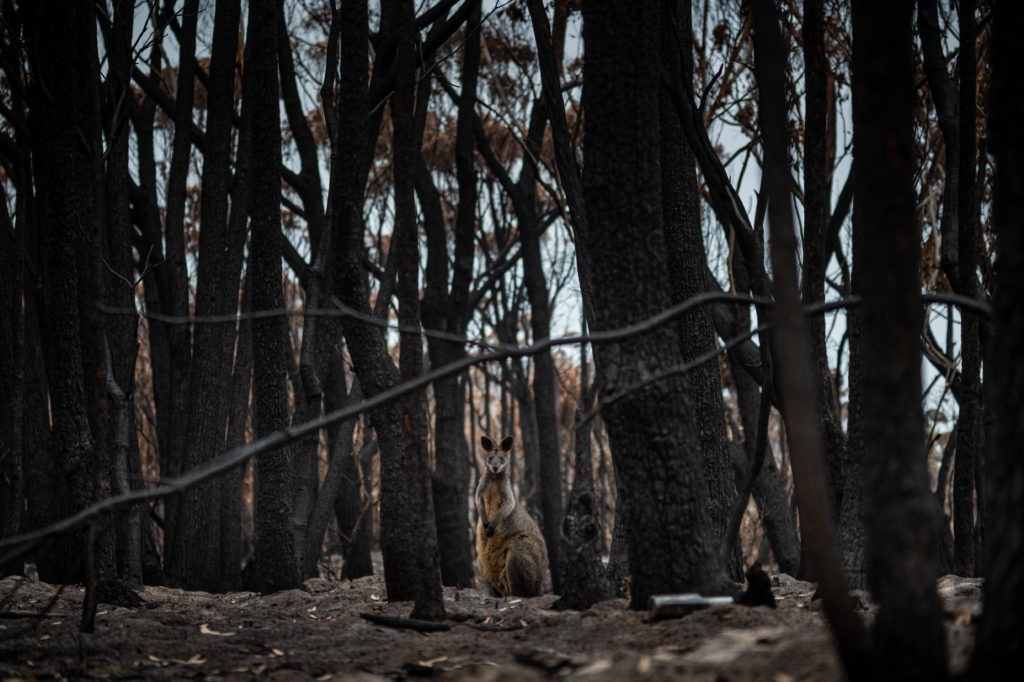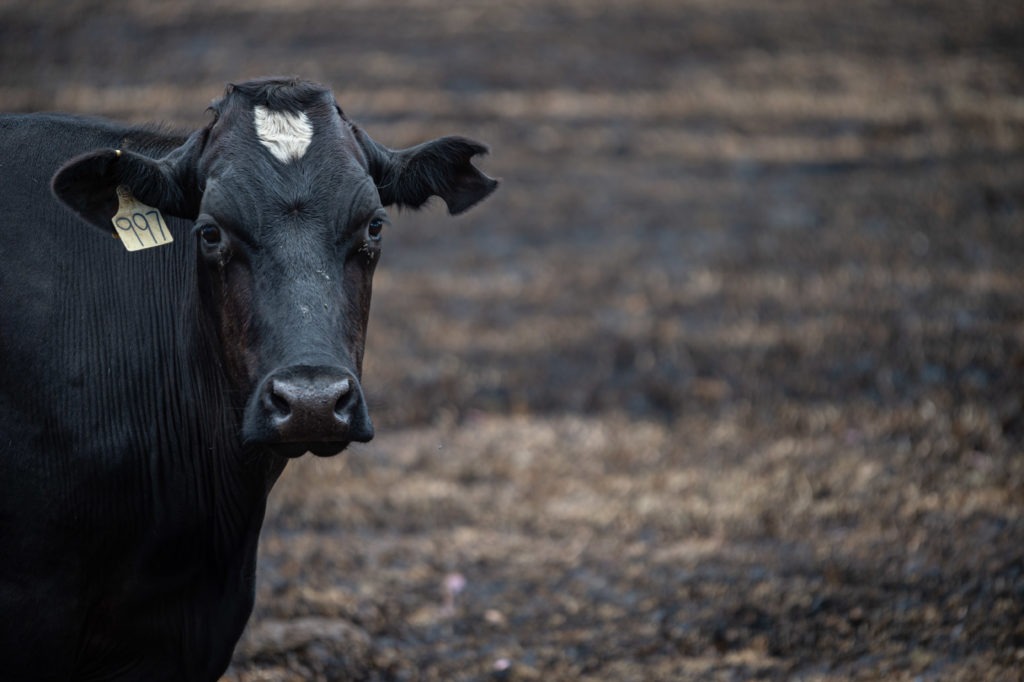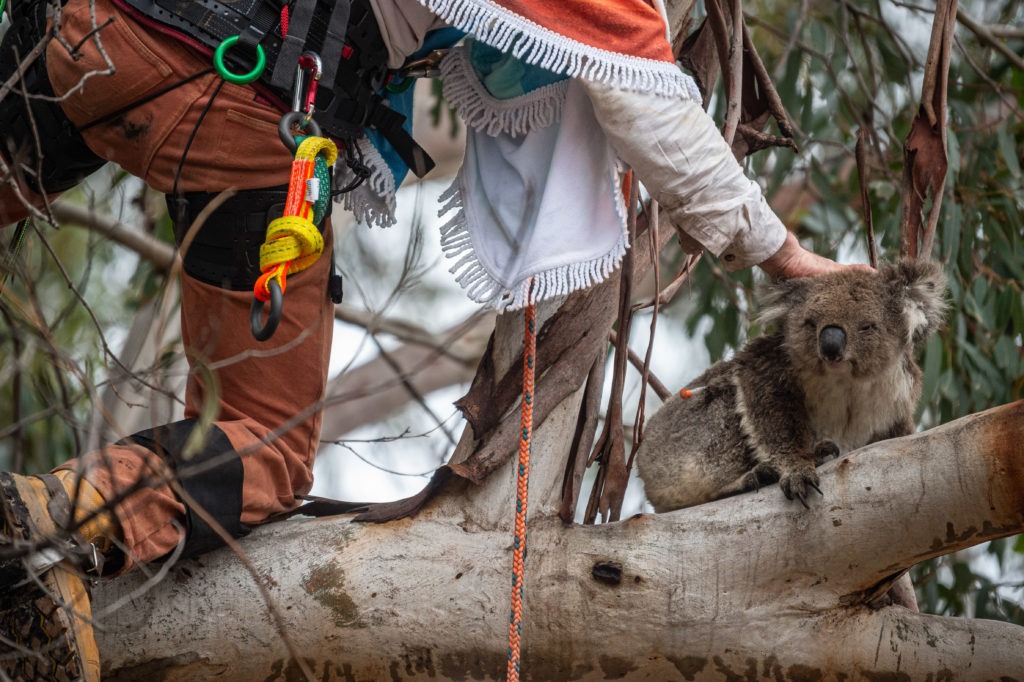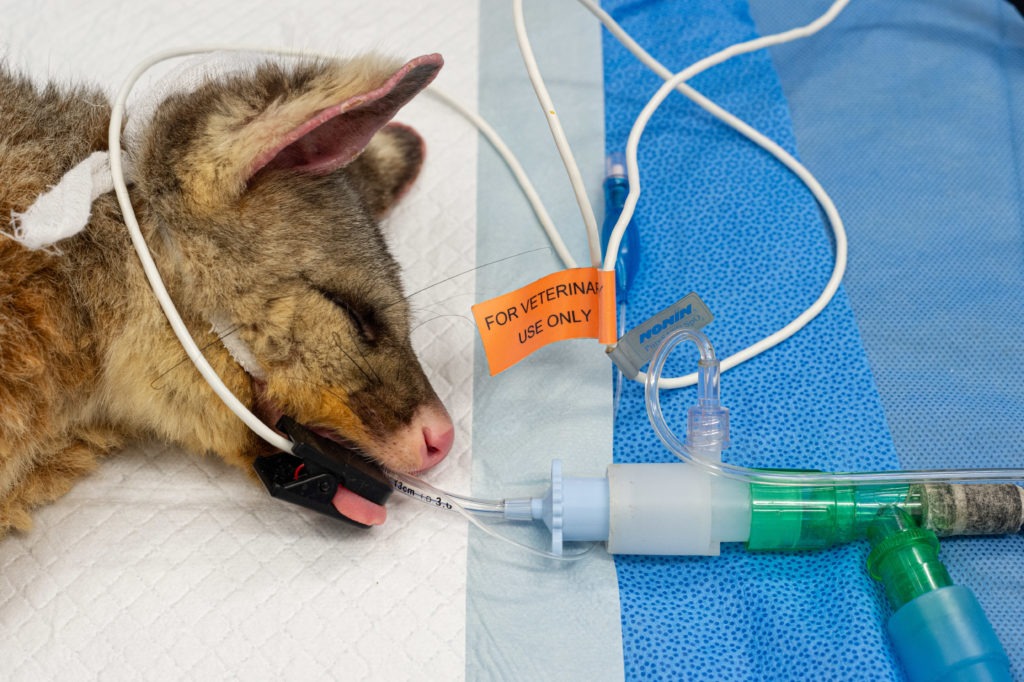Just over a year ago, the east coast of Australia was covered in thick smoke and ash – from the burning bush and from the burning bodies that called that bushland home.
Still haunted by the preventable loss of billions of animals’ lives, the devastation caused by recent floods in NSW has been another blow to our wildlife populations and to farmed animals living on those flood plains.
What went wrong during black summer and what lessons did we learn? How can we protect wildlife, sanctuary animals and farmed animals in future natural disasters?
PhD Candidate and Teaching Fellow at Melbourne Law School, Ashleigh Best’s research outlined below aims to provide answers.

Counting the nonhuman toll of a fire season like no other
Twelve months on, we remember the 2019-2020 Australian bushfire season for its profoundly devastating impacts on humans and animals alike. A report commissioned by the WWF estimates that almost 3 billion native vertebrate animals were in the paths of the fires and were therefore likely killed, injured or otherwise displaced. Many ecosystems and habitats, some of which had not burned for tens of millions of years, are feared to have been permanently damaged by the infernos.
The implications for Australia’s biodiversity are immense. The unprecedented severity of the fires saw several already threatened species further imperiled, with at least 20 pushed substantially closer to extinction. At the close of the fire season, no less than 119 species were identified as needing urgent management intervention. Among these is the iconic koala: the aforementioned report estimates that 60,000 individual members of this slow-moving species were affected by the fires, with some populations contracting by over 70%.
While these findings are astounding, they concentrate exclusively on impacts to wild native animals. Accordingly, they do not account for the tens of thousands of farmed animal casualties who either perished during the fires or survived but were later euthanised due to their injuries.

Identifying lessons learned: Governments respond
Multiple inquiries were established to investigate what lessons could be drawn from the tragedy. Chief among these was the Royal Commission into National Natural Disaster Arrangements, whose Final Report recognises the need for more informed and cohesive arrangements for wildlife response. It recommends that governments capture better information about species’ geographical spread and conservation status. This can then be used to ensure fire recovery strategies for threatened species are well-informed and targeted.
The Commission also observes that, in some states, wildlife relief functions are formally integrated within broader emergency management frameworks. This beneficially promotes cooperation among first responders, such as fire crews, and wildlife protection organisations, and ensures wildlife rescuers can access fire grounds promptly and safely. As a good example, the Commission refers to South Australian Veterinary Emergency Management Inc (SAVEM): a participating agency under SA’s Framework for Managing Animals in Emergencies, which is part of the State Emergency Management Plan. SAVEM is usually permitted to enter fire-affected areas within 48 hours, and was rapidly deployed to the Kangaroo Island fires to retrieve and treat wildlife in distress.
The issue of domestic animal disaster management received less attention and is yet to be meaningfully acknowledged and thoroughly addressed on a federal scale. Both the Royal Commission’s Final Report and the Senate Inquiry’s Interim Report note that residents faced obstacles to evacuating with their animals, particularly large animals. Not only was transporting animals at short notice logistically challenging, they were also only accepted at certain evacuation centres. The Final Report of the NSW Bushfire Inquiry recommends that protocols be adopted to support individuals evacuating with animals; Victoria instated similar systems in the aftermath of Black Saturday.

Heeding lessons learned: this season’s bushfires
Due to the influence of La Niña, much of the east coast of Australia was spared a fire season comparable to that of 2019-2020 during the summer just passed. However, parts of South Australia and Western Australia, as well as World Heritage-listed K’gari (Fraser Island) in Queensland, contended with severe blazes.
South Australia’s animal losses were substantial, with the toll for wild and farmed animals alike estimated to be in the thousands. SAVEM was again promptly deployed to the fire grounds to search for injured wildlife on the very same day that the fires were officially declared contained, as the Adelaide Koala and Wildlife Hospital and local vets prepared for an influx of patients. Such a coordinated response is testament to SA’s enviably efficient system for rescuing and treating wildlife in disasters.
The wildlife welfare response to the K’gari fires was particularly challenging given the site’s isolation. The Queensland Government is coordinating measures to protect affected wildlife, including by developing a dedicated ecological “recovery unit”. However, the State has attracted criticism for its decision to refuse offers of assistance from global animal welfare groups despite suggestions that animals on the island – including a nationally significant dingo population – were facing malnourishment. It is interesting to note that, unlike SA, Queensland does not have a disaster plan for animals.
While Western Australia’s Perth Hills fires caused extensive physical damage and loss of animal life, some reassuring stories of successful animal evacuations emerged from the disaster. For example, hundreds of horses and other farmed animals, such as goats, were reported to have sheltered from the blaze in saleyards, local showgrounds and stables. Although one animal refuge was destroyed by fire, its resident animals – some of whom were evacuated, while others remained on the property – fortunately survived. However, in other cases, roadblocks impeded individuals’ efforts to return to their properties to rescue or tend to their animals. The situation for wildlife was particularly perilous; notwithstanding that a handful of individual wild animals were treated with injuries, wildlife rescuers held grave fears that many simply succumbed to the intensity of the fires.

Improving animal disaster management: recommendations for reform
Australia has shown some promising progress when it comes to planning for animals in disasters. Victoria, South Australia, Western Australia and New South Wales have plans designed to coordinate disaster preparedness and response capabilities in respect of animals, each of which is guided by the National Planning Principles for Animals in Disasters. Inquiries into the 2019-2020 bushfires also highlight the plight of affected animals to varying extents, and responses to animals in recent bushfire events suggest that improvements to systems are being made.
However, further action is required. We need a nationally consistent and comprehensive approach to planning for animals in disasters. This means making state and territory plans consistent across Australia, and ensuring they cater to the complex needs of animals, their owners and those who rescue and care for them during disasters. Such a measure could be facilitated by a federally-endorsed model disaster plan for animals.
Secondly, in addition to sound preparedness and response, we urgently need to implement proactive measures to prevent and mitigate the adverse impacts of disasters on animals. For wildlife, this means conserving habitat, particularly habitat connectivity and refuges, to maximize species’ prospects of escaping and recovering from impending hazards. The interests of farmed animals must also be considered. Unless farming operations are to be discontinued in fire-prone areas, animals must be kept in paddocks with the least exposure to fire risk.
Natural disasters are projected to increase in intensity and frequency as a result of climate change. We must be prepared to respond to animals when hazards strike and in the meantime, we should address factors within our control, such as land clearing and poor agricultural design, that make animals vulnerable to the effects of those hazards in the first place.
Read more from Ashleigh Best:
- How we plan for animals in emergencies, The Conversation, 2019
- 3 billion animals were in the bushfires’ path. Here’s what the royal commission said (and should’ve said) about them, The Conversation, 2020
- The latest animal law research from Australian PhD Candidates, Dr. Meg Good, Voiceless Blog, 2019

Ashleigh Best is a PhD Candidate and Teaching Fellow at Melbourne Law School.
Ashleigh researches the legal status of animals in disasters and has been involved in animal law initiatives for several years. In 2020, she was awarded the RSPCA Australia Sybil Emslie Animal Law Scholarship for her research.
Voiceless Blog Terms and Conditions: The opinions expressed on the Voiceless Blog are those of the relevant contributors and may not necessarily represent the views of Voiceless. Reliance upon any content, opinion, representation or statement contained in the article is at the sole risk of the reader. Voiceless Blog articles are protected by copyright and no part should be reproduced in any form without the prior consent of Voiceless.
Like this post? Receive updates from Voiceless straight to your inbox by signing up to our newsletter here.


